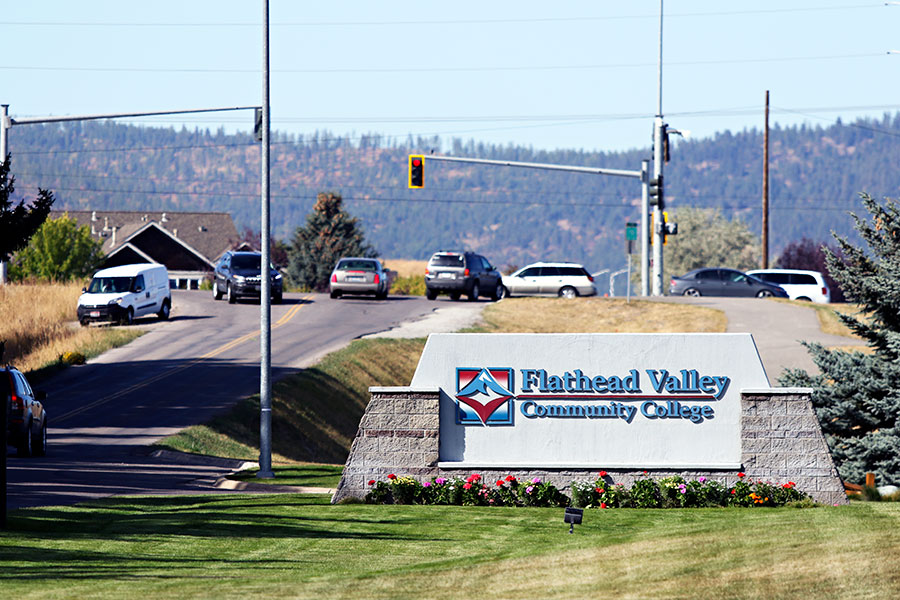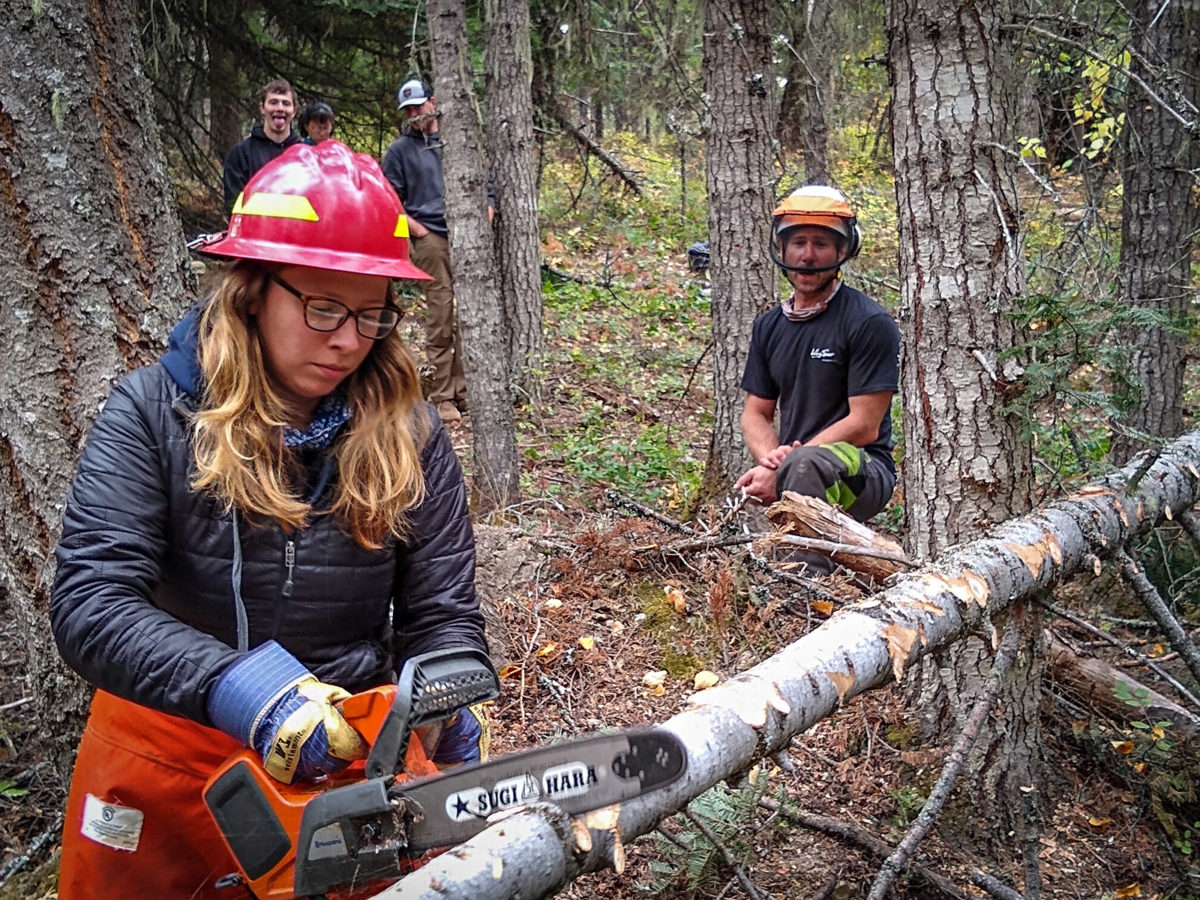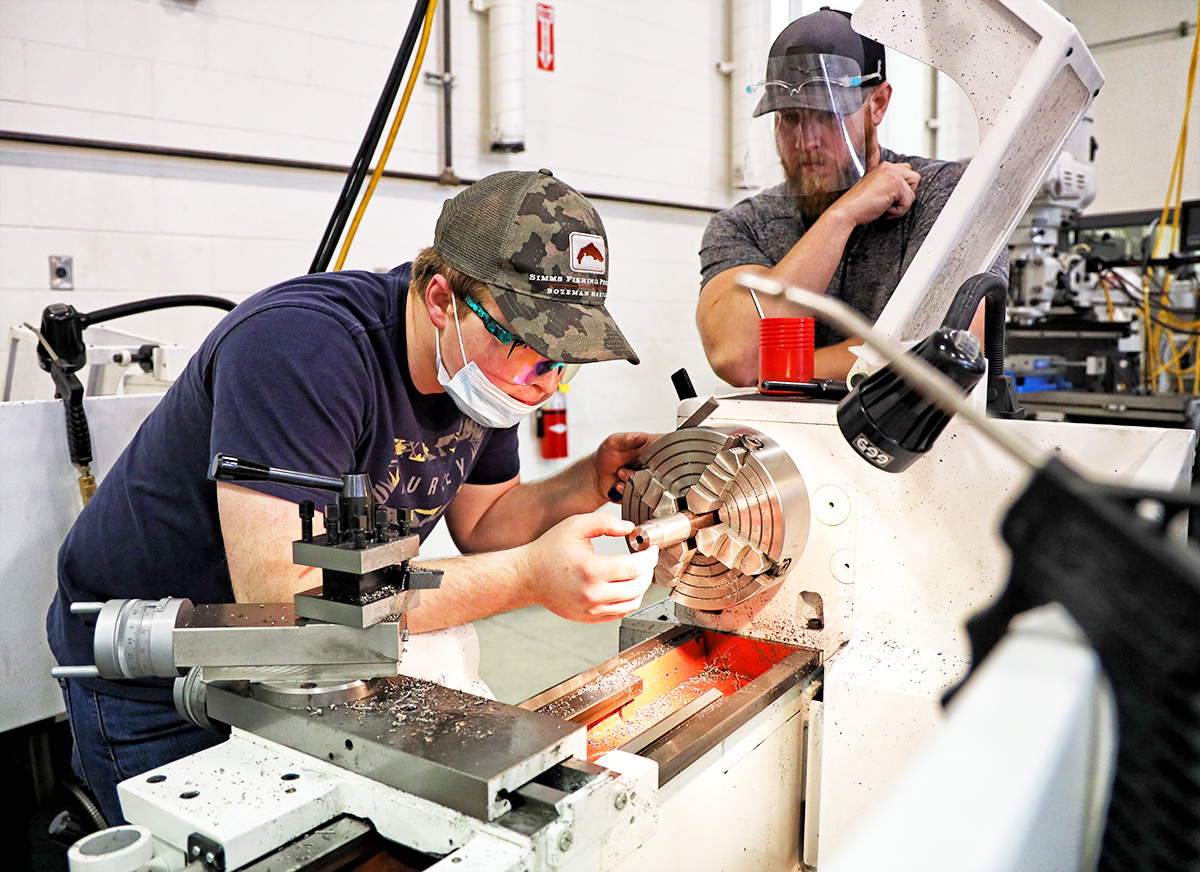Building a Grassroots Workforce
FVCC offers innovative programs tailored to meet the needs of local industries and demographics, including natural resources, firearms technologies and a unique welding partnership with Columbia Falls High School set to graduate its first class
By Myers Reece
When Jane Karas was named the nation’s top community college executive in 2016, Flathead Valley Community College Board of Trustees Chair Shannon Lund noted that Karas had “guided our institution through its most dramatic period of growth and academic innovation.”
“She has worked to meet local workforce needs,” Lund continued, “including those in advanced manufacturing and healthcare, and has explored a wide range of specialized programs while ensuring that FVCC’s core academic programs are continually enhanced.”
Five years later, the community college under Karas, who has been FVCC president since 2001, has only furthered its national reputation for shrewdly adapting to address the shifting needs of local industries and demographics through a combination of innovative trades programs and a strong academic base repertoire. The school’s enrollment has skyrocketed during Karas’ tenure, with 3,744 students in fiscal year 2020, and is consistently the largest of all two-year and community colleges in Montana.
The college has built a robust healthcare curriculum, particularly for nursing, as well as a suite of occupational trades from which 70% of graduates secure local jobs. From beer brewing and business to HVAC and humanities, the school strives to account for a diverse student population, ranging from traditional 18-year-olds to non-traditional second career seekers to retired hobbyists, as well as an ever-changing job market.
As FVCC prepares to hold its spring commencement on May 7 at Legends Stadium in Kalispell, where 299 students will graduate with 312 degrees, the Beacon caught up with students and instructors in three unique programs that are designed to nurture a local workforce through industry-tailored training and job-ready skills.

Welding Technology CTS
Nine Columbia Falls High School (CFHS) students will walk across the stage at FVCC’s graduation ceremony and then do it again on June 5, this time at their high school commencement.
They represent the first-ever graduating class of the Welding Technology CTS program, which is unparalleled in Montana and offered through a partnership between CFHS and FVCC’s Running Start. Graduates will have earned a certificate of technical studies (CTS) and 26 college credits through three years’ worth of intensive welding training and other educational requirements, beginning as sophomores.
Cole Karlin, an 18-year-old senior, doesn’t know if he would be graduating high school, let alone college, if it weren’t for the welding program.
“Sophomore year I had a 1.5 GPA,” Karlin, who has earned an internship at Acutech Metal Works, said. “Now I’m on the honor roll. It’s a big jump.”
Ben Schaeffer, the program’s instructor at CFHS, said students like Karlin, who aren’t innately drawn to regular day-to-day school, have found a comfort zone in the welding program, which requires them to maintain grades in other courses, thus focusing their overall school effort while they work toward a specific passion.
“I would say there are probably three students that wouldn’t have completed high school without the work that has been done here,” Schaeffer said. “Not every kid is college bound. These are the kids that want to work. They found an area that was comfortable for them and gave them a reason they wanted to come to school.”

Schaeffer has been developing the program for almost a decade with Beth Romain, director of FVCC’s Running Start, which gives high school students the opportunity to affordably earn college credits. He praised a long list of other supporters and collaborators at CFHS and FVCC for turning it into a reality.
The program has been crafted with relevant courses such as business communications, blueprint reading, SolidWorks and technical writing, tailored specifically to the students. Shelley Eberhardy, an academic coordinator with Running Start, said Schaeffer has gone out of his way to work with students, setting them up with tutors if necessary, to help them through areas in which they may not excel, perhaps English or math.
Schaeffer said the program shows the kids, many of whom come from low-income households, that they can find success without a four-year degree, or perhaps it will jumpstart a college education. There are immediately tangible perks as well, as demonstrated by two students who already have local welding jobs with crystallizing career paths in a field that offers solid wages.
“We think it gives them a foot in the door and looks good on a resume; we hope it opens a lot of doors,” Schaeffer said. “And it gives them that little bit of a nudge: ‘Hey, I am capable. I took college classes and I was successful.’”

A number of the students, Eberhardy said, are from homes where post-secondary education isn’t emphasized or even considered a viable option — Karlin, for instance, is the first in his family to walk in a college commencement — and the welding program offers a pathway. Some will continue with courses at FVCC to earn more certifications and perhaps an associate’s degree.
Eberhardy is also pleased to see girls participating.
“It’s pretty exciting to know that we’re getting women into this field,” she said.
Gracie Mee, a 17-year-old senior, is one of those young women. Armed with six semesters’ worth of college-level welding education, Mee feels good about her job prospects, as well as her role as a pioneer for the program.
“It’s so exciting to know we’re the first class able to do this in high school and to know that I can get jobs at a younger age,” she said.
Schaeffer and Eberhardy placed the program in the context of an overall renewed emphasis on the trades, designed to address an erosion of the skilled labor force. Eberhardy manages a grant that FVCC earns called the Montana Perkins Reserve, which has a component focused on developing trades. She said there is amplified conversation over best approaches to “building pathways” between students, as young as middle school, and colleges and employers.
“A big goal at FVCC in general is we want to support what the industry needs and support employers,” she said. “FVCC is always evaluating what programs we can offer that will help create those pipelines (so employers) can get trained local workforce coming in instead of having to hire from out of state.”

Natural Resources
Students who complete FVCC’s natural resources program walk out with a comprehensive foundation in water, soil, insects, wildlife, environmental policy, resource conservation, recreation management, fire and timber. And they learn a wide-ranging array of tools and skills, from old fashioned to cutting edge, like cross-cut saws, horse packing, remote-sensing technology and drones.
“They’re really well rounded,” said Christina Relyea, a natural resources professor and director of FVCC’s honors program. “They know how to do a lot with technology and traditional skills. That makes them pretty employable because they’ve been trained in a much broader way than in other programs that would be similar to ours. They’re exposed to most things they would encounter in a natural resource field.”
Pretty employable may be an understatement. In fact, for several years running, every program graduate has secured a job in the natural resources field, from private companies to public agencies.
“We really have populated the valley with quite a few students who are working actively in the region and also into Idaho,” Relyea said.

Students can choose from a two-year associate of applied science (AAS) natural resource degree or an associate of science (AS) transfer track that would set them on the path to a four-year degree, often at the University of Montana and also Montana State University, in areas such as forestry, wildlife biology, resource conservation and rec management.
Glacier National Park internships through the Glacier National Park Conservancy are also available, as is a new internship through the state Department of Natural Resources and Conservation.
Relyea and Tim Eichner, a natural resources professor specializing in surveying and geospatial technology, have spent the better part of a decade building up the program, using their own professional experience in the field as a base. Eichner works as a Type 1 incident management GIS specialist in the summer, while Relyea spent over a decade in the backcountry working in areas such as water quality and insects.
Their efforts have been bolstered by adjunct professors with similarly expansive resumes in natural resources, including John Fraley, Allen Chrisman, Rick Trembath, Fred Flint, Nick Merriman, Abbie Hutton and Diane Whited.
Many students range from ages 24-30, and their years of post-high school life experience have nudged them toward natural resources. A number are “legacy students” whose families work in natural resources. The common thread between them all is a desire to work outside.
“They want to be out in nature, fishing and hunting and hiking,” Relyea said. “They’re outdoor-oriented students.”

The program’s reputation has led to heightened interest from local companies and agencies, and each student in this year’s graduating class already has a summer job in natural resources.
“People are contacting us and we’re like, ‘Sorry, everyone is spoken for,’” Eichner said.
The program has access to a 60-acre “living laboratory” off Foothill Road, including a 5-acre stand overgrown with grand fir where students can participate in a complete silviculture process, from inventory to prescription to implementation with chainsaws.
“You can talk about density and management all day long, but it doesn’t actually sink in until you’re manipulating vegetation,” Eichner said.
Students also recently completed a project in conjunction with FWP at the Sekokini Springs Native Fish Hatchery in Coram, in which they conceptualized, designed and constructed floating islands to serve as both refuge for vulnerable juvenile fish in the ponds and vegetated habitat. The process ranged from researching and deciding materials to engineering, sawing and hammering.
“We’re doing the prototypes,” Relyea said. “If it works, this design could be picked up really anywhere to be used in a hatchery scenario. It’s really neat.”

Firearms Technologies
Jakob Campbell, 20, was in Bozeman studying fish and wildlife management at Montana State University when he grew more interested in his father’s studies than his own. His dad, Chris Campbell, was enrolled in FVCC’s firearms technologies program, and Jakob headed back to Kalispell to join him.
Now Jakob is finishing up his first year while Chris is in his second, wrapping up his associate’s degree. They both see opportunity awaiting them, albeit in different corners of the field. Chris has used the training as a springboard to obtain his federal license as a firearms dealer and start a business, while Jakob already has a job at Proof Research.
While Jakob is eyeing a career path in firearms manufacturing, he said the broad skills learned in the program, from woodworking to machining to welding, open up numerous doors.
“You could take this and start a woodworking business, or do pretty much any kind of trade,” he said.
Brandon Miller, a special operations veteran who worked as a weapons sergeant, launched the program in 2012 and, after a few years away, is back as director. It’s the only program of its kind in Montana, and Miller said there are few others like it, with its array of offerings and technology, anywhere in the West.

With access to millions of dollars’ worth of cutting-edge technology, including lathes and CNC machines, students not only learn the intricacies of firearms manufacturing and technology, but also skills that can be applied to a wide variety of other manufacturing and engineering jobs.
Miller maintains close relationships with manufacturers in the Flathead Valley’s firearms industry, who lend expertise and donate parts and equipment. The relationship is reciprocal in that FVCC churns out potential employees trained in numerous skills. Roughly one-third of current students are employed in the local firearms industry.
Students graduating with a two-year associate’s degree could use it as a foundation to pursue a four-year engineering degree or immediately qualify for a range of manufacturing jobs, firearms or other. Miller notes that they learn everything from intricate theory to advanced CNC machining, and they’re versed in both metal and wood. Miller said machinists typically earn between $20 and $40 an hour.
“So much in the trades has been lost over time and I think there’s been a resurgence in trying to bring manufacturing back in the U.S.,” Miller said. “There’s a drive to get that back and that’s part of what we’re trying to do.”
Summer and fall course registration is open now at FVCC with rolling admissions. Visit fvcc.edu/apply, or for more information about a specific program, visit fvcc.edu/request-info or call (406) 756-3847.